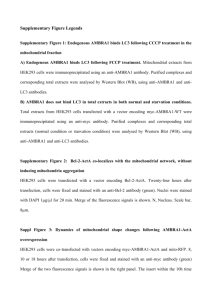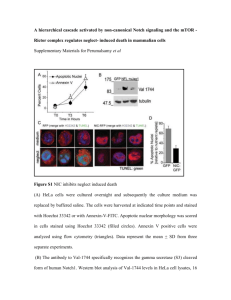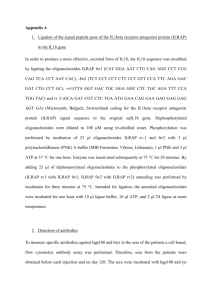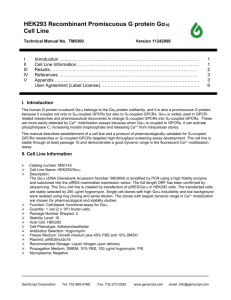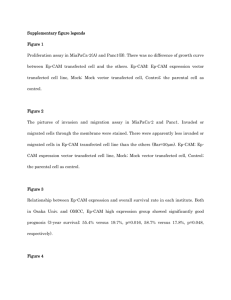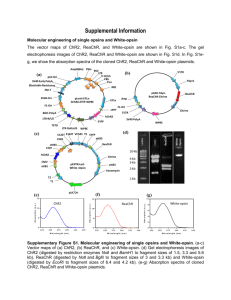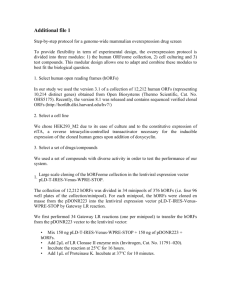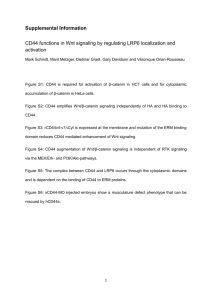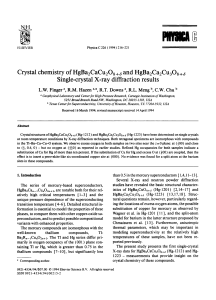Additional file 8
advertisement
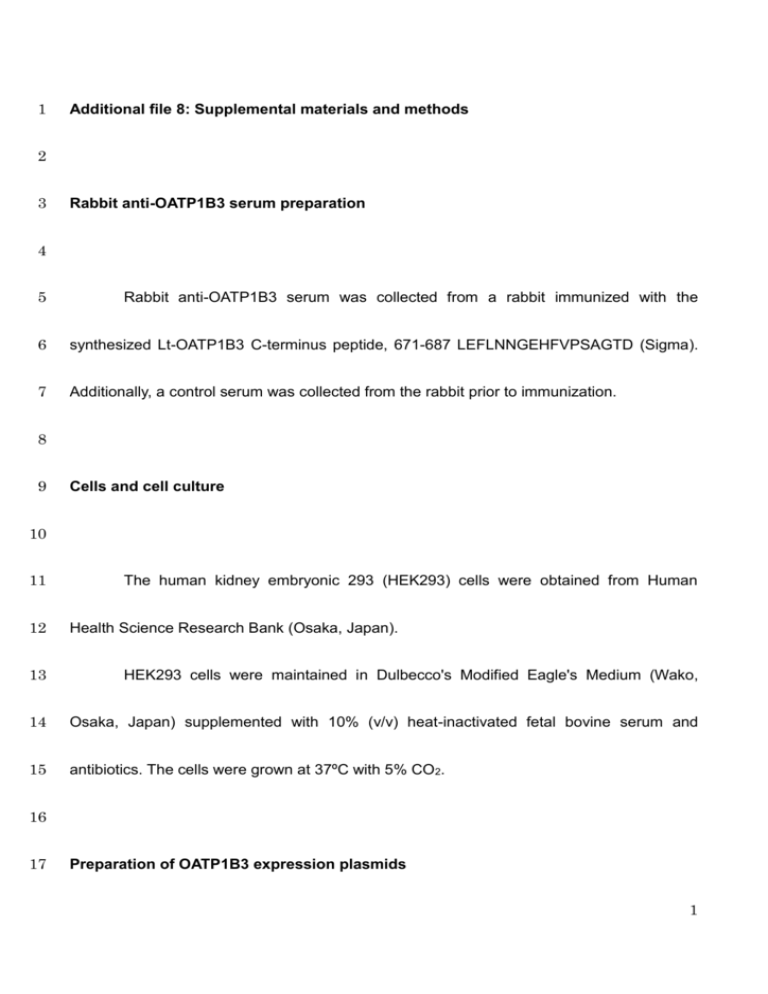
1 Additional file 8: Supplemental materials and methods 2 3 Rabbit anti-OATP1B3 serum preparation 4 5 Rabbit anti-OATP1B3 serum was collected from a rabbit immunized with the 6 synthesized Lt-OATP1B3 C-terminus peptide, 671-687 LEFLNNGEHFVPSAGTD (Sigma). 7 Additionally, a control serum was collected from the rabbit prior to immunization. 8 9 Cells and cell culture 10 11 12 The human kidney embryonic 293 (HEK293) cells were obtained from Human Health Science Research Bank (Osaka, Japan). 13 HEK293 cells were maintained in Dulbecco's Modified Eagle's Medium (Wako, 14 Osaka, Japan) supplemented with 10% (v/v) heat-inactivated fetal bovine serum and 15 antibiotics. The cells were grown at 37ºC with 5% CO2. 16 17 Preparation of OATP1B3 expression plasmids 1 18 19 Ct-OATP1B3 cDNA containing the entire sequence from transcription start site to 20 stop codon was subcloned into the pcDNA3.1(-)Neo (Ct1B3/p3.1) (Life Technologies, 21 Carlsbad, CA) from the Ct-OATP1B3 expression plasmid (Ct1B3/pTOPO), which had been 22 prepared in our previous study [5]. Ct-OATP1B3-C (lacking the N-terminal 47 amino acids of 23 Lt-OATP1B3, Fig. 1) cDNA was amplified by polymerase chain reaction (PCR) using the 24 Ct1B3/p3.1 25 (5’-GTGGATCCATTATGAAAATTTCCATCACT-3’ 26 5’-GCTCTAGAGCAATGTTAGTTGGCAGCAGCA-3’) 27 pBapo-CMVpur (Ct1B3-C/pBapo) (Takara Bio, Siga, Japan). Similarly, Ct-OATP1B3-v1 28 (lacking the N-terminal 28 amino acids of Lt-OATP1B3, Fig. 1) cDNA was cloned into the 29 pBapo-CMVpur 30 (5’-GTGGATCCTAGCAGATGTTCTTGGCAGCCC-3’ 31 GCTCTAGAGCAATGTTAGTTGGCAGCAGCA-3’). 32 expression plasmid (Lt1B3/p3.1) was described in the previous report [18]. as a template (Ct1B3-v1/pBapo) with the primer set and and using subcloned the primer and The into preparation the set 5’- of Lt-OATP1B3 33 34 Development of HEK293 cells stably expressing each OATP1B3 isoform 2 35 36 The Ct1B3-C/pBapo or Ct1B3-v1/pBapo was transfected into HEK293 cells using 37 Lipofectamine LTX (Life Technologies) according to the manufacturer’s protocol. The cells 38 transfected with Ct1B3-C/pBapo (Ct-1B3-C/HEK) or Ct1B3-v1/pBapo (Ct-1B3-v1/HEK) were 39 selected by supplying 0.6 μg/mL puromycin into the culture medium. Using the same 40 procedure, HEK293 carrying empty pcDNA3.1(-)Neo or empty pBapo-CMVpur were 41 developed (mock/HEK). Single cell cloning of Ct-1B3-C/HEK was performed by a colony 42 formation method. HEK293 cells stably expressing Lt-OATP1B3 (Lt-1B3/HEK) were 43 developed in our previous study [18]. 44 Transport assay was performed using the method described in the method section 45 of the main text. Briefly, one day after the cells were seeded, they were exposed to sodium 46 butyrate (10 mM, Sigma) for 24 hours, after which the transport assay was performed using 47 CCK-8 and E2G as substrates. 48 49 Immunocytochemistry 50 51 Immunocytochemistry was performed essentially using the methods described in 3 52 our previous report [18]. Briefly, HCT116 cells were seeded on the collagen-coated coverslip, 53 after which the cells were transfected with the Lt1B3/p3.1, Ct1B3-C/pBapo, Ct1B3-v1/pBapo, 54 or an empty vector using MultiFectam transfection reagent according to the manufacturer’s 55 protocol (Promega, Fitchburg, WI). Forty-eight hours after transfection, the cells were fixed 56 and permeabilized with BD Cytofix / Cytoperm kit (BD Bioscience, Franklin Lakes, NJ). After 57 blocking with 3% bovine serum albumin, the cells were incubated with rabbit polyclonal 58 anti-OATP1B3 antibodies (200-fold dilution, Sigma). The secondary antibody used was 59 Alexa Fluor 488-conjugated donkey anti-rabbit antibody (200-fold dilution, Life Technologies). 60 Immunofluorescence was analyzed using confocal laser scanning immunofluorescence 61 microscopy (LSM 710; ZEISS, Oberkochen, Germany). 62 63 Transient expression and functional analysis of Ct-OATP1B3 in HCT116 cells 64 65 HCT116 cells were transfected with the Lt1B3/p3.1, Ct1B3-C/pBapo, 66 Ct1B3-v1/pBapo, or an empty vector using MultiFectam transfection reagent according to 67 the manufacturer’s protocol. Transport assay was performed using the same method as that 68 described above. 4
